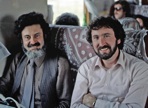
China had fascinated me for years, so I jumped at the chance to travel there, as soon as Western tourists were allowed, only as tour groups, in 1981. I accepted the invitation of Dennis Cox, through ASMP, the American Society of Magazine Photographers, and joined a group of 15 professional and amateur photographers for this luxury tour and photo workshop. Our instructor was Norman Snyder.
We landed in Beijing via Tokyo from San Francisco, we stayed at the State Guest House, where US presidents had been housed, few hotels being available at that time, the tourism infrastructure not yet built; we had our first group meal seated at huge round tables eating only with chopsticks.
Throughout the trip we would go sightseeing during the day and participate in discussions and seminars in the evenings. We would drive our official guides crazy, because, as soon as the minivan stopped, we would spread out in all directions searching for images to capture with our cameras, rather than listen to the boring explanations; we offered a living example of unruly individual enterprise to people accustomed to group thinking and obedience. We elicited curiosity and surprise wherever we went, or even fear in small children unaccustomed to seeing foreigners walking around.
It was exhilarating and enlightening to talk to people, those few who knew English and were allowed to speak with us, and we were invariably welcomed. I had learnt a few words in Chinese: “Hello, how are you? May I take your picture? Thank you.” Where language was a barrier, I used gestures and facial expressions to make my wishes known, like that time in Gullin when I convinced a local man to let me borrow his bicycle to ride around for an hour; I left my driver’s license with him, handed him some money, pointed at my wrist watch, and he understood the nature of the exchange.
In those years all Chinese were forced to wear blue uniforms, except those who wore green because they were in the Army; the only exceptions being small children, who were allowed colorful clothes and scarves. Many people wore surgical masks to protect their mouth from flu germs during the cold winter months, it was December; the only vegetable available during that season was cabbage.
As we traveled to Nanjing, Hangzou and a Shanghai, that was a far cry from the modern city of today, but already a busy port, we formed bonds among ourselves and with our Chinese guides; we had lively discussions about the Cultural Revolution, enforced with great cruelty in the 1960s by Mao Tse-Tung, still revered five years after his death, and the current political system, where any ties with the old order had been severed, causing a loss of continuity with the traditions of a once magnificent civilization. There was only one channel broadcasting from a national television station and no stores where regular people could buy consumer goods.
When we reached Guilin and went on a boat ride on the Li River, we felt the mystical power of those round hills, so often depicted in traditional Chinese landscape paintings. We also became stranded in our modest hotel, because of bad weather, in a place where the airport was not equipped with instruments-only landing. Finally, in Hong Kong, still a British protectorate, we witnessed the shocking co-mingling of old China with the modern Western world. After several weeks of Chinese food, for breakfast, lunch and dinner, it was a relief for me to find restaurants that served Italian food. Then, after tearful goodbyes with some members of our group, I was off to explore Tokyo for the first time, another, very different Asian culture.


